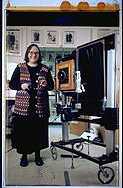Elsa Dorfman

Elsa Dorfman (born April 26, 1937) is a portrait photographer who works in Cambridge, Massachusetts. She is now known for her use of a Polaroid 20 by 24 inch camera (one of only 6 in existence),[1] from which she creates large prints. She has photographed famous writers, poets, and musicians including Bob Dylan and Allen Ginsberg.[2]
Her principal published work, originally published in 1974 and out of print but now available on her web site, is Elsa's Housebook - A Woman's Photojournal,[3] a photographic record of family and friends who visited her at 19 Flagg Street in Cambridge when she lived there during the late 1960s and early 1970s. Many famous people, especially literary figures associated with the Beat generation, were in her circle of acquaintance and as a result are prominent in the book, including Lawrence Ferlinghetti, Allen Ginsberg and Peter Orlovsky, Gary Snyder, Gregory Corso, and Robert Creeley, in addition to people who would become notable in other fields, such as radical feminist Andrea Dworkin and civil rights lawyer and Foundation for Individual Rights in Education co-founder Harvey A. Silverglate (who would become Dorfman's husband). She has also photographed staples of the Boston rock scene such as Jonathan Richman frontman of The Modern Lovers, and Stephen Tyler of Aerosmith.

Dorfman moved to New York City in 1959 and found a job as a secretary to the editors at Grove Press, a leading Beat publisher.[4] When she later moved home to Cambridge to pursue her master's degree, she called herself the "Paterson Society" and began arranging readings for many Beat authors who had become friends, maintaining an active correspondence with them as they traveled the world. By 1962, she was teaching fifth grade; poet Paul Blackburn visited her in school one day and read to the children "to the shock of the very straight principal." A year later, in 1963, Dorfman began working for the Educational Development Corporation whose photographer, George Cope, introduced her to photography in June 1965. She made her first sale two months later, in August 1965, for $25 of a photograph of Charles Olson which was used on the cover of his book The Human Universe. Due to economic limitations, she did not buy her own camera until 1967, when she sent a check for $150 to Philip Whalen who was then in Kyoto, Japan, and he in turn enlisted Gary Snyder, who could speak Japanese, to purchase the camera and mail it to her. In May 1968, she moved into the Flagg Street house which would become the basis of her Housebook.
See also
References
- ↑ According to her web site FAQ, Frequently Asked Questions about Elsa Dorfman's Portrait Photography on the Polaroid 20x24 Camera
- ↑ "Allen Ginsberg on Flagg Street, 1973 at the Jewish Museum (New York)". Thejewishmuseum.
- ↑ Elsa Dorfman's Housebook
- ↑ Dorfman explains her background in her Housebook The Camera
External links
| Wikimedia Commons has media related to Elsa Dorfman. |
- Official website
- "Elsa Dorfman Photographs, 1957-1970", University Archives & Special Collections at UMass Boston
|